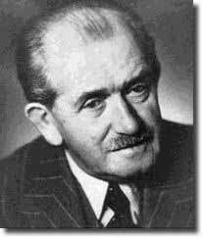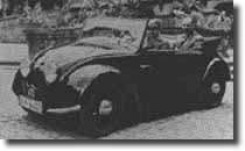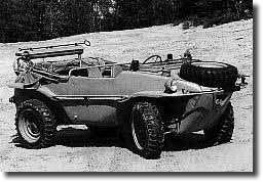Volkswagen-History

The history began as a dream of Ferdinand Porsche. He had a vision about building a car that everybody could afford.
Porsche was a technical genius who already in his younger years worked with all sorts of technical problems and their solutions. He was later employed by a large number of car companies like Lohner, Austro-Daimler, Mercedes, Daimler-Benz and Steyr before he opened up his own design bureau in 1930. At least 10 years earlier he had been designing a small, affordable car for Daimler, but the project got canceled on a prototype level as Daimler thought it was to risky.
An early drawing of a peoples carIn 1931 he ordered his staff of engineers to start designing a car with a water cooled three cylinder engine, independent suspension and the capacity to carry four adult at good comfort in 100 kph. The price was to be kept as low as possibly, in order to make the car affordable to the masses.
Porsche tried to sell his idea to the german auto industry, and in 1932 he found a partner in Zündapp. Three prototypes were built using Porsche's original design equipped with a new engine. That engine however turned out to have a sever cooling problem and melted after only ten minutes of running. Zündapp withdrew from the project and left Porsche to find a new partner.
The NSU prototypeThe project was picked up by NSU, a motor cycle manufacturer wanting to expand into cars. The problematic engine was scrapped and a completely new air cooled four cylinder engine was built. That engine was to be the predecessor of the flat four engine we know today. The design of the NSU bared many similarities to the beetle and was equipped with the revolutionary torsion bar suspension. The engine was placed in the rear in order to avoid the traditional and complicated transmission with a separate gear box, drive shaft and rear axle. Three prototypes called "type 32" were built and tested, but due to the economical climate in Germany at the time NSU withdrew from the project and Porsche was alone once again.
At that time, in 1933, on the Berlin Motor show the newly selected chancellor Adolf Hitler announced his plans to produce a small car for the German people. When Porsche heard that Hitler shared his dream he quickly arranged a meeting with him to find a business partner. At the meeting Hitler was very optimistic but had a few demands before being willing to sign a contract. These were:
* The car should be able to carry two adults and three children.
* It should have a cruising speed of 100 kmp.
* The fuel consumption should not exceed 0,8 liter per 10 km.
* The engine had to be air cooled.
* The car should also be able to carry three soldiers and a machine gun!!
* The price should be less than 1.000 RM.
The last demand was going to be especially hard to achieve since the cheapest car on the market at the time was the Opel P4 with a price tag of 1.500 RM.
Despite these somewhat unrealistic demands Porsche accepted and a contract was signed in 1934 stating the delivery of three prototypes within ten month. The prototypes were to be built by RDA (the German Auto Manufacturers Association). Even though Porsche had a great experience of building small cars a number of modifications were necessary mainly in order to meet the target price of 990 RM.
As RDA realized that the project had a chance to succeed (and didn't want to see that happen) they deliberately delayed the project in order to make Porsche miss his deadline and thereby lose the contract.
One of three W1 prototypesPorsche missed his deadline, but Hitler realized what had happened and placed the whole project under government supervision. The three prototypes were eventually delivered in October 1936 and was called "W1". The next series of 30 cars built during 1937 was called VW 30.
A prototype from the W30 seriesThat same year GeZuVor (Gesellschaft Zur Vorbereitung des Deutschen Volkswagen, GmbH, The Group Planning The German Peoples Car, Inc.) was founded and became responsible for the production of the car. The GeZuVor was a part of DAF (Deutsches Arbeiter Front, The German Workers Front) which was an organization receiving contributions from all workers and organized all kinds of family activities. A section called KDF (Kraft Durch Freude, Strength Through Joy) got the task of selling the car now referred to as "KDF wagens".
Between 1935 and 1937 a total of 50 prototypes were built. A number of engines were also tested before the decision was taken to go ahead with the flat four air cooled engine designed by Franz Reimspeiss. That engine was more or less to be unchanged until this day.
The prototypes were submitted to a rough test program in order to expose weaknesses. For example they had to withstand days of full throttle runs on the newly built German autobahns. Due to the extensive tests SS soldiers had to be recruited as test drivers since the test program lasted for about 1600 million km.
The official 1938 presentation of the KDF-wagenThe final design was decided and updates were made (Hitler himself is supposed to have been involved during this process). The final 44 prototypes were built in 1938 and another 50 in 1939 for demonstration and advertising purposes. The beetle now looked like we know it.
Since the facilities to produce the car didn't exist, Hitler decided to build a whole new town called KDF stadt just for this purpose. It was founded in May 26 1938 and the production was supposed to start in September 1939, but in Marsh 1939 World War II broke out. After the war the town was renamed Wolfsburg from Werner von Schulenberg of Wolfsburg who was forced to give up his land for this project.
The way you were supposed to become an owner of a KDF wagen was unique. The idea was to save for it by buying a 5 RM stamp each month and when you had enough of stamps (200) the car would be delivered.
But when the war broke out all plans of production were halted and a total of 337.000 people who had been saving for a car got cheated. They wasn't compensated until 1961 after a lawsuit in a German court. A settlement was reach where they either got a check of 100 DM or a 600 DM discount when buying a new bug.
The bug goes to war
The war created an enormous demand for munition. The factory was therefore taken over by the German air traffic ministry and the production converted to meet the demand. The factory produced stoves, V1 bombs, repaired aircraft's etc.
KubelwagenIn an attempt to keep the car alive Porsche designed a cheap and practical military vehicle based on the beetle pan. It had a slightly raised suspension and was equipped with a limited slip differential for better traction. The result was the type 82 or Kübelwagen (bucket car), and became so popular that captured ones often were used by the allied troops. A total of 50.000 were made.
SchwimmwagenAn amphibious version of the type 82 called at first type 128 and later type 166 was also made. It was quickly nick named Schwimmwagen (swimming car) and there were about 15.000 made. For propulsion in the water the car was equipped with a retractable propeller connected to the crank shaft of the engine. Top speed in the water was about 5 mph and the front wheels acted as a rudder.
A Kubel- and a KommendeurwagenFor the officers and other higher ranking militaries the factory also produced military versions of the beetle and a prototype called type 87 or kommendeurwagen (commander car). It was basically a beetle body on a four wheel drive Schwimmwagen chassis. Note that both cars in the picture are equipped with producer-gas units since there was a shortage of petrol towards the end of the war.
After the war
The remains of the factory in 1945After the war the factory ended up in the british zone, which perhaps was lucky since neither the russians, americans nor the french wanted to start the production of the little car that already then was considered to be outdated.
Ivan HirstThe british selected major Ivan Hirst as responsible for the factory. He wanted to start the production of cars again since the war had created a huge demand for a small cheap car.
Despite the fact that 2/3 of the factory was destroyed by the allied bombing the workers under Hirst´s leadership managed to assemble 58 cars during the remaining of 1945, mainly from spare parts found in the remains. That impressed the british officers who quickly ordered 5.000 cars. The factory was saved!
Early production lineIn 1946 the factory was ordered to produce 1.000 cars a month and in that year the total number of cars produced was 10.020. By now the company was officially named "Volkswagen" and the town it was produced in "Wolfsburg". The first export took place in 1947 when a dutch car dealer named Ben Pon bought five cars. (It was by the way Ben Pon who more or less was the driving force behind the development and introduction of the type 2 transporter that was introduced in 1949).
Dispite a steady increase in the production it was soon realized that it had to be increased even more to make the company profitable. The export was minimal and limited to only to a small number of neighboring countries. But once Germany on June 20 1948 changed its currency from RM (reich marks) to DM (deutsch mark) the business boomed.
Heinrich NordhoffThat same year the company was handed over to the German government who appointed Heinrich Nordhoff as the senior executive. He had prior to the war been in charge of Opel and his biggest contribution that also turned out to be crucial was the vision and realization of a network of dealers and service spots.
A parking lot full of splitsIn 1950 they started an assembly plant in Ireland in order to get around the import ban of German products. This proved to be a success and expanded to South Africa (1951), Brazil (1953) and Australia (1955). As the factories back in germany couldn't keep up with the demand the foreign production increased to include manufacturing of parts. Soon these "foreign" bugs were 100% built in their respective countries. The number of plants grew and soon included Mexico and new ones back in Germany.
The production kept growing and in 1955 Volkswagen were producing 1.000 cars a day.
A few mile stones in Volkswagens history:
* 1955, August 20. 1 million cars produced.
* 1972, February 17. The bug overtakes Fords model T as the most produced single model car with over 15 million made.
* 1981, May 15. The 20 millionth bug rolls off the assembly line in south america.
To this day over 22 million bugs have been producedproduction was stoped in July 2003 in Mexico.





